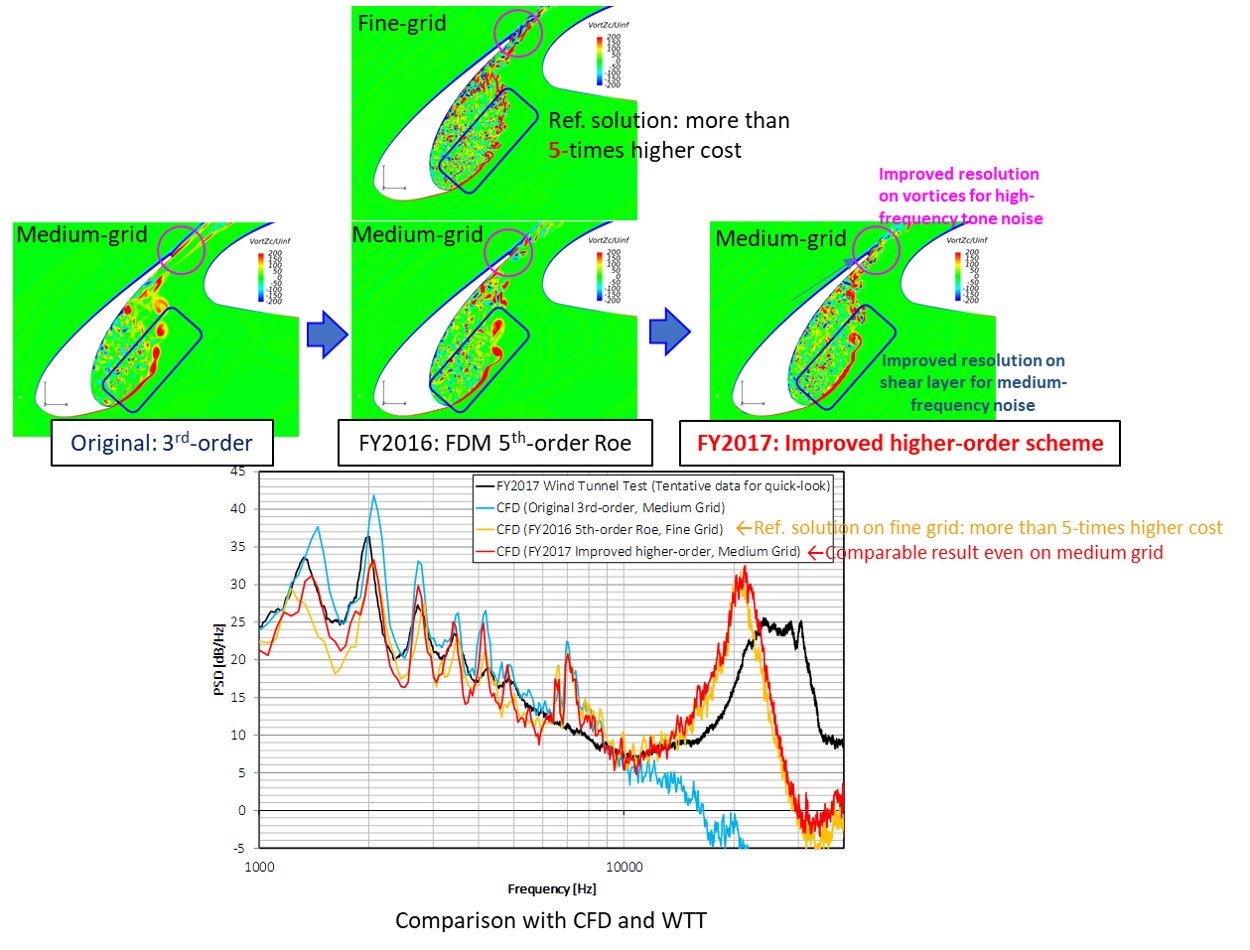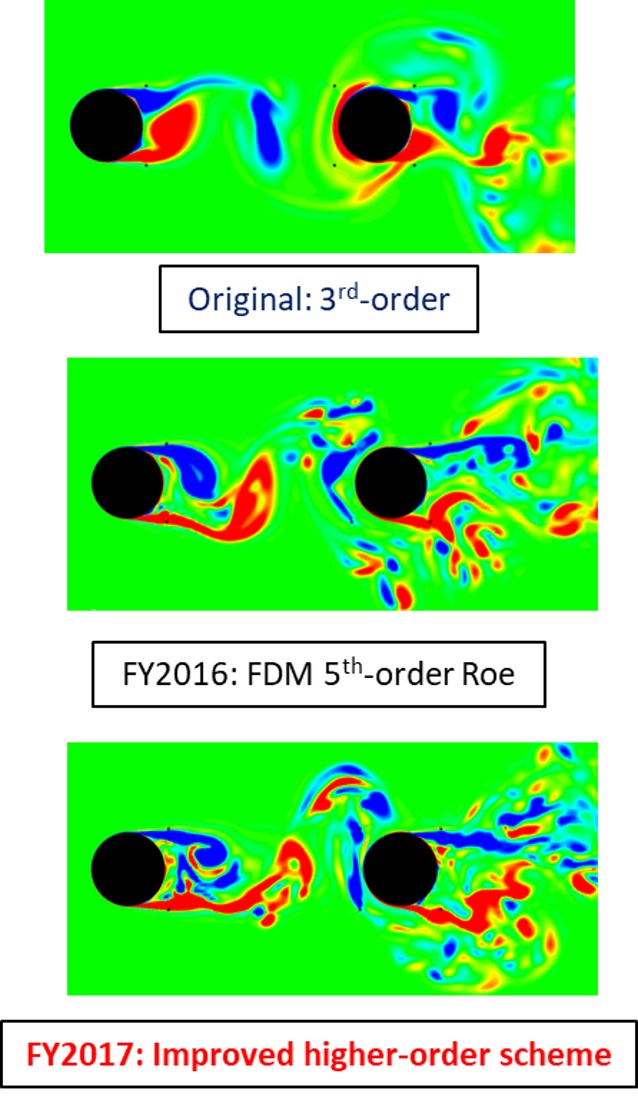Environment Conscious Aircraft Systems Research in Eco-wing Technology:Airframe-Engine Noise Reduction Technology
JAXA Supercomputer System Annual Report April 2017-March 2018
Report Number: R17EA0602
Subject Category: Aeronautical Technology
- Responsible Representative: Yoshikazu Makino, Aeronautical Technology Directorate Next Generation Aeronautical Innovation Hub Center
- Contact Information: Dongyoun Kwak kwak.dongyoun@jaxa.jp
- Members: Takehisa Takaishi, Mitsuhiro Murayama, Yasushi Ito, Ryotaro Sakai, Tohru Hirai, Kentaro Tanaka, Kazuhisa Amemiya, Gen Nakano, Tomoaki Ikeda, Fumitake Kuroda, Keisuke Ohira, Dongyoun Kwak, Yosuke Matsumura, Seiichiro Morizawa, Ryutaro Furuya
Abstract
Innovative drag reduction technologies are investigated to reduce the fuel consumption for a conventional aircraft configuration. Aircraft noise prediction technologies and the conceptual design technologies are also developed for future aircraft which achieve low noise and high efficiency.
Reference URL
Please refer to ‘Eco-wing technology | ECAT – Environment-Conscious Aircraft Technology Program | Aeronautical Technology Directorate‘.
Reasons for using JSS2
The JSS2 is used to develop the airframe, engine, and interference noise prediction tools that have high or middle fidelities for applicable to MDO design with high fidelity CFD and FEM analysis. The airframe-engine installation and/or shielding effects are one of important key issues for the future aircraft. The accuracy of current low fidelity analysis for the airframe, engine, and interference noise prediction is not good enough for application to MDO design with high fidelity CFD and FEM analysis toward the future low-noise aircrafts. The JSS2 is required for development of high or middle fidelity noise prediction tools for competitiveness in technology.
Achievements of the Year
The accuracy and efficiency of airframe noise prediction (CFD/CAA) tools were improved by increasing the resolution of sound sources on the complex geomeries. And its effect was evaluated by analysis on benchmarking problems proposed in AIAA Workshop on Benchmark Problems for Airframe Noise Computations (BANC).
The performance of a JAXA’s CFD/CAA solver, UPACS was improved for JSS2 by installing an improved treatment between each grid block developed in 2016 and a low-dissipation scheme to achieve higher fidelity and speed-up on the complex geometries . Fig.1,2 show the flow features by CFD and CAA analisys on a tandem cylinder and a leading edge slat which are the benchmarking problems. Small scaled vorties were clearly observed on the shear layer region and separation area. The resolution for sound sources was increased by combination of improved higher-order scheme using a low-dissipation upwind SLAU scheme and a central difference scheme developed in 2017. Furthermore, the convergence of the numerical analysis was also enhanced as well as higher flow resolutions. Improvement of the accuracy and efficiency on on the complex geometries were achieved on JAXA’s CFD/CAA tools.

Fig.2: Benchmark problem for slat noise prediction (JAXA/NASA Collaboration Research: 30P30N wind tunnel test)
Publications
■ Non peer-reviewed papers
1)Tomoaki Ikeda, et.al., “Aerodynamic Noise Simulations Resolved by Higher-order Spatial Schemes on JAXA’s UPACS”, 14th International Conference on Flow Dynamics, 2017.11.
Usage of JSS2
Computational Information
- Process Parallelization Methods: MPI
- Thread Parallelization Methods: OpenMP
- Number of Processes: 20 – 800
- Elapsed Time per Case: 349.00 hours
Resources Used
Fraction of Usage in Total Resources*1(%): 1.30
Details
Please refer to System Configuration of JSS2 for the system configuration and major specifications of JSS2.
| System Name | Amount of Core Time(core x hours) | Fraction of Usage*2(%) |
|---|---|---|
| SORA-MA | 10,627,256.06 | 1.41 |
| SORA-PP | 2,057.55 | 0.03 |
| SORA-LM | 0.00 | 0.00 |
| SORA-TPP | 0.00 | 0.00 |
| File System Name | Storage Assigned(GiB) | Fraction of Usage*2(%) |
|---|---|---|
| /home | 497.16 | 0.34 |
| /data | 20,313.45 | 0.38 |
| /ltmp | 9,073.39 | 0.68 |
| Archiver Name | Storage Used(TiB) | Fraction of Usage*2(%) |
|---|---|---|
| J-SPACE | 95.39 | 4.10 |
*1: Fraction of Usage in Total Resources: Weighted average of three resource types (Computing, File System, and Archiver).
*2: Fraction of Usage:Percentage of usage relative to each resource used in one year.
JAXA Supercomputer System Annual Report April 2017-March 2018



